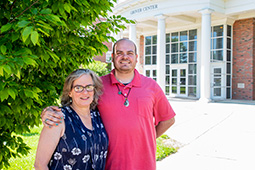Speaking up for diversity: Creating vocal identity through speech therapy can be important for transgender self-confidence

Photo courtesy of: College of Health Sciences and ProfessionsSarah Taylor (left) and delfin bautista (right)
A voice can be as unique as a fingerprint and provide an easily recognizable association to others. For the transgender community, voice is a key element to a realized identity.
“For individuals who are transgender, voice is a very high consideration although it probably isn’t an area of practice people think about first,” said Sarah Taylor, M.A., CCC-SLP, clinical supervisor of Speech-Language Pathology in Ohio University’s College of Health Sciences and Professions. “Vocal cords are tiny and picky. We help create a voice that reflects the individual, but is also safe to produce.”
As the individual treating the majority of adults within the Hearing, Speech and Language Clinic, referrals for transgender patients looking to alter their voice came to Taylor who said, “The clinic’s commitment to Safe Space and service availability as well as an interest in voice evolved into the current programming offered here. The hope is that these services will expand.”
With speech therapy, altering a voice to a different pitch is possible although the time frame greatly depends on the individual. Time has to be spent changing the “muscle memory” of the cords while time is also spent on identifying the sound the person is seeking to achieve.
While changing a person’s pitch is important, and what some believe is the most audible change, there’s more to establishing an identifying voice.
“It’s certainly not just pitch,” said Taylor. “The difference in gender communication is with the speaking voice. Women tend to use longer vowels, talk faster and have different intonations than men. Once we get the pitch, we add the vowel length or intonation, the eye gaze, how we sit and put it all together.”
Little by little, the changes and achievements are what Taylor celebrates while her clients also become more empowered by their new skill.
“The risk for self-harm is high in the transgender community during transition. Being able to claim your voice helps. And being able to stay in your transgender voice identity without thinking about it is a real accomplishment,” she said.
The process is not always easy. Taylor pointed out that some people even use two voice systems; some who have not revealed their transgender nature in a professional or family atmosphere will use one voice and a different voice in a private setting while they work through the process.
“I think our voice says a lot about who we are and being able to create a space where people are able to find their voice in order to be able to express and share who they are is important,” said deflin bautista,* director of the Lesbian, Gay, Bisexual, Transgender Center at OHIO. “We often talk about things like clothing, makeup and hair when it comes to the transition journey but voice is also a part of that.”
Taylor and bautista have worked together on identifying words commonly used by men and those used by women as well as identifying gestures and facial expressions of the different sexes. Through the LGBT Center, bautista has been able to work with students who have utilized speech therapy to their advantage.
“You could hear a definite change in tone and see a real change in them,” bautista said. “They felt better and were happier. It was exciting and really inspiring to see that journey.”
Ohio University’s Hearing, Speech and Language Clinic offers an extensive range of services including testing for preschool-age students to adults with a staff capable of assessing disorders of hearing, language, speech, voice and swallowing. Contact 740-593-1404 for more information.
* delfin bautista prefers the lowercase form of their name and the pronouns of they/them.
